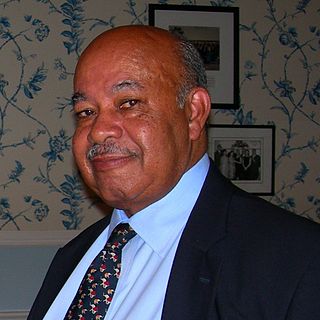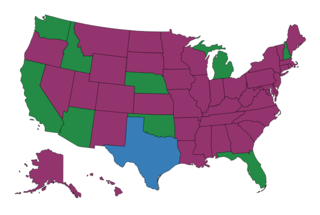Related Research Articles
Affirmative action or positive discrimination, refers to a set of policies and practices within a government or organization seeking to include particular groups based on their gender, race, sexuality, creed or nationality in areas in which they are underrepresented, such as education and employment. Historically and internationally, support for affirmative action has sought to achieve goals such as bridging inequalities in employment and pay, increasing access to education, promoting diversity, and redressing apparent past wrongs, harms, or hindrances.
Racial quotas in employment and education are numerical requirements for hiring, promoting, admitting and/or graduating members of a particular racial group. Racial quotas are often established as means of diminishing racial discrimination, addressing under-representation and evident racism against those racial groups or, the opposite, against the disadvantaged majority group. Conversely, quotas have also been used historically to promote discrimination against minority groups by limiting access to influential institutions in employment and education.
Reverse discrimination is a term for discrimination against members of a dominant or majority group, in favor of members of a minority or historically disadvantaged group. Groups may be defined in terms of ethnicity, gender identity, nationality, race, religion, sex, or sexual orientation.
Racial discrimination is any discrimination against any individual on the basis of their skin color, or racial or ethnic origin. Individuals can discriminate by refusing to do business with, socialize with, or share resources with people of a certain group. Governments can discriminate in a de facto fashion or explicitly in law, for example through policies of racial segregation, disparate enforcement of laws, or disproportionate allocation of resources. Some jurisdictions have anti-discrimination laws which prohibit the government or individuals from discriminating based on race in various circumstances. Some institutions and laws use affirmative action to attempt to overcome or compensate for the effects of racial discrimination. In some cases, this is simply enhanced recruitment of members of underrepresented groups; in other cases, there are firm racial quotas. Opponents of strong remedies like quotas characterize them as reverse discrimination, where members of a dominant or majority group are discriminated against.
Color blindness is a term that has been used by justices of the United States Supreme Court in several opinions relating to racial equality and social equity, particularly in public education. The term references the physical phenomena of color blindness or color vision deficiency – a deficiency in the perception of color that is typically hereditary and was first studied extensively by John Dalton in 1794.
An affirmative action bake sale is a type of campus protest event used by student groups to performatively criticize affirmative action policies by charging students different prices depending on which social or racial group they belong to. It has also been used to raise awareness of racial or sexual wage gaps.

Wardell Anthony "Ward" Connerly is an American political and anti-affirmative action activist, businessman, and former University of California Regent (1993–2005). He is also the founder and the chairman of the American Civil Rights Institute, a national non-profit organization in opposition to racial and gender preferences, and is the president of Californians for Equal Rights, a non-profit organization active in the state of California with a similar mission. He is considered to be the man behind California's Proposition 209 prohibiting race- and gender-based preferences in state hiring, contracting and state university admissions, a program known as affirmative action.
Reverse sexism is a term for sexism directed towards men and boys.
Reverse racism or reverse discrimination is the concept that affirmative action and similar color-conscious programs for redressing racial inequality are a form of anti-white racism. The concept is often associated with conservative social movements and the belief that social and economic gains by black people in the United States and elsewhere cause disadvantages for white people.

Affirmative action in the United States is a set of laws, policies, guidelines, and administrative practices "intended to end and correct the effects of a specific form of discrimination" that include government-mandated, government-approved, and voluntary private programs. The programs tend to focus on access to education and employment, granting special consideration to historically excluded groups, specifically racial minorities or women. The impetus toward affirmative action is redressing the disadvantages associated with past and present discrimination. Further impetus is a desire to ensure public institutions, such as universities, hospitals, and police forces, are more representative of the populations they serve.
United Steelworkers of America v. Weber, 443 U.S. 193 (1979), was a case regarding affirmative action in which the United States Supreme Court held that Title VII of the Civil Rights Act of 1964 did not bar employers from favoring women and minorities. The Court's decision reversed lower courts' rulings in favor of Brian Weber whose lawsuit beginning in 1974 challenged his employer's hiring practices.
Constitutional colorblindness is an aspect of United States Supreme Court case evaluation that began with Justice Harlan's dissent in Plessy v. Ferguson in 1896. Prior to this, the Supreme Court considered skin color as a determining factor in many landmark cases. Constitutional colorblindness holds that skin color or race is virtually never a legitimate ground for legal or political distinctions, and thus, any law that is "color-conscious" is presumptively unconstitutional regardless of whether its intent is to subordinate a group, or remedy racial discrimination. The concept, therefore, has been brought to bear both against vestiges of Jim Crow oppression, as well as remedial efforts aimed at overcoming such discrimination, such as affirmative action.
Laissez-faire racism is closely related to color blindness and covert racism, and is theorised to encompass an ideology that blames minorities for their poorer economic situations, viewing it as the result of cultural inferiority. The term is used largely by scholars of whiteness studies, who argue that laissez-faire racism has tangible consequences even though few would openly claim to be, or even believe they are, laissez-faire racists.
Wygant v. Jackson Board of Education, 476 U.S. 267 (1986), was a case before the United States Supreme Court. It is the seminal case for the "strong-basis-in-evidence standard" for affirmative action programs.
Bushey v. New York State Civil Serv. Comm'n, 733 F.2d 220, 224 is a US labor law case from the Second Circuit applying the test for affirmative action from United Steelworkers v. Weber.
Students for Fair Admissions, Inc. v. President and Fellows of Harvard College is a lawsuit concerning discrimination against Asian Americans and the affirmative action program in Harvard University's student admissions process. The organization Students for Fair Admissions and other plaintiffs filed a lawsuit against Harvard College in 2014 in the United States District Court for the District of Massachusetts, claiming that the college discriminates against Asian American applicants in its undergraduate admissions process.
Johnson v. Transportation Agency, 480 U.S. 616 (1987), is the only United States Supreme Court case to address a sex-based affirmative action plan in the employment context. The case was brought by Paul Johnson, a male Santa Clara Transportation Agency employee, who was passed over for a promotion in favor of Diane Joyce, a female employee who Johnson argued was less qualified. The Court found that the plan did not violate the protection against discrimination on the basis of sex in Title VII of the Civil Rights Act of 1964.
Fred L. Pincus is an American sociologist and emeritus professor of sociology at the University of Maryland—Baltimore County, where he taught for 44 years. He is known for researching claims of reverse discrimination by whites and males.
Substantive equality is a fundamental aspect of human rights law that is concerned with equitable outcomes and equal opportunities for disadvantaged and marginalized people and groups in society. Scholars define substantive equality as an output or outcome of the policies, procedures, and practices used by nation states and private actors in addressing and preventing systemic discrimination.

Proposition 16 is a California ballot proposition that appeared on the November 3, 2020, general election ballot, asking California voters to amend the Constitution of California to repeal 1996's Proposition 209. Proposition 209 amended the state constitution to prohibit government institutions from considering race, sex, or ethnicity, specifically in the areas of public employment, public contracting, and public education. Therefore, Proposition 209 banned the use of race- and gender-based affirmative action in California's public sector.
References
- 1 2 Pincus, Fred L. (2003). Reverse Discrimination: Dismantling the Myth . Lynne Rienner Publishers. pp. 46. ISBN 9781588262035.
- 1 2 Swain, Carol M. (2002-06-10). The New White Nationalism in America: Its Challenge to Integration . Cambridge University Press. p. 223. ISBN 9780521808866.
- ↑ Bean, Jonathan J. (Summer 2003). "Shame of the Cities: Setting Aside Justice for the "Disadvantaged"". The Independent Review . 8 (1): 47–52. JSTOR 24562595.